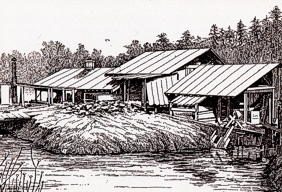 This
information is taken from the following publication
This
information is taken from the following publication
of the American Chemical Society, Division of the History of Chemistry and
The Office of Communications:
A National Historic Chemical Landmark
Discovery
of the Commercial Process for Making Calcium Carbide and Acetylene
On May 2, 1892, a chance discovery in the village
of Spray (now Eden), North Carolina, proved to be a milestone in the history
of the chemical industry.
On that date, Thomas L. Willson, a struggling
young Canadian inventor, accidentally discovered the process for making
calcium carbide and acetylene in commercial quantities.
A plaque marking the designation was presented to
Spray Cotton Mills, owner of the site in Eden, North Carolina, on May 2,
1998, 106 years to the day after the discovery of the process.
The inscription reads: "At this site on May 2,
1892, while searching for an economical process to make aluminum, Canadian
inventor Thomas L. Willson (1860-1915) accidentally discovered the
electric-arc process for preparing calcium carbide, which reacts with water
to form acetylene. The first commercial calcium carbide plant, built by
local entrepreneur James Turner Morehead (1840-1908), operated here between
1894 and 1896. From this beginning, calcium carbide and acetylene
manufacturing spread around the world. Acetylene, used first for lighting
homes, railways, mines, and marine buoys and then for oxyacetylene welding,
became one the foundations fo the synthetic organic chemicals industry."
The original one-acre site of the Willson Aluminum
Company plant where the discovery was made is now partially covered by the
Spray Cotton Mill, which was built in 1896 after the Willson plant burned.
Nothing remains of the Willson plant except the waterwheel, which generated
power for the cotton mill until the 1970s.
Out of the discoveries at Spray (now Eden),
numerous companies sprang up around the world, the oldest and best known
being Union Carbide Corporation, Originally Union Carbide Company.
Read more about this fasinating history...